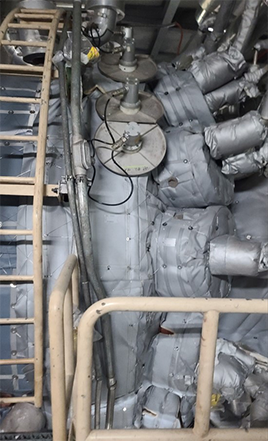Detachable thermal insulation materials are designed to protect high-temperature equipment, such as
pipes, valves, flanges, turbines, and instrumentation, used in various plants like power plants, ships, and
petrochemical facilities. These materials prevent internal heat loss, freezing, and fires, while also
safeguarding workers.
Components and Types

| Temperature | Inner Layer | Outer Layer | Insulation | Thickness |
|---|---|---|---|---|
| ~ 200℃ | • Silicone-coated | • Silicone-coated • Teflon-coated fabric |
• Glass wool • glass felt • aerogel blanket |
25T~75T |
| 200℃ ~ 350℃ | • vermiculite fabric • silica fabric |
• glass felt • mineral wool • Aerogel blanket |
50T~100T | |
| 350℃ ~ 450℃ | • vermiculite fabric • silica fabric |
• ceramic wool • Aerogel blanket |
100T~150T | |
| 450℃ ~ 800℃ | • Silicone-coated • ceramic wool |
• ceramic wool | 150T~200T |
Advantages
- Internal/external materials and insulation integrates to install and dismantle products in a short time.
- Removable insulation makes it easy for non-professionals to install.
- When constructing thermal insulation materials, dust does not fly, so you can work in a clean environment.
- Excellent insulation improves energy efficiency and has a carbon neutrality effect.
Features
- 단 Exceptional insulation reduces heat loss, achieving outstanding energy savings.
- Durable and reusable, suitable for installation by general users.
- Recyclable, minimizing environmental impact.
- Overcomes the limitations of conventional insulation, offering a more efficient approach to energy consumption.
Installation Photos








